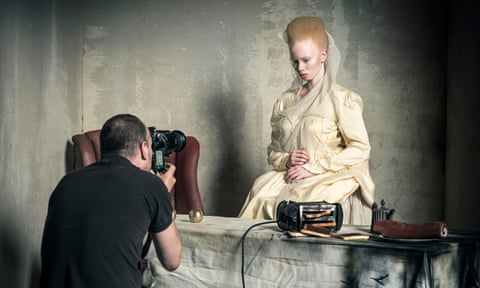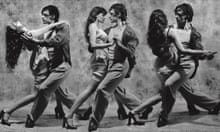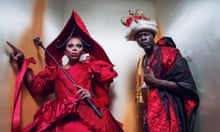‘I chop off people’s heads – and I like it.” Naomi Campbell looks up from her phone to tell a group of journalists about her role in the latest Pirelli calendar. It is inspired by John Tenniel’s original illustrations for Alice in Wonderland, and Campbell is on set in a photographic studio in north London, surrounded by a twisted fairytale scene of mouldy jam tarts and scorched doll houses.
Quick GuideA brief history of the Pirelli calendar
Show
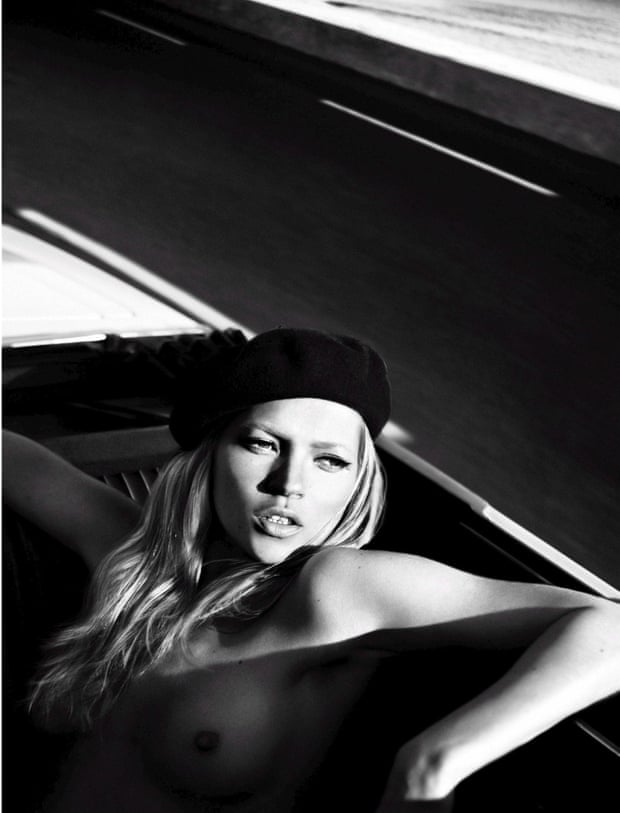
What is it?
The Pirelli calendar was first published in 1963 as a corporate gift for clients and customers of the Italian tyre company. The annual publication of the calendar – which has traditionally featured conventionally sexy images of nude women – has become an unlikely fixture on the fashion calendar because it attracts big-name photographers, models and celebrities. Its blatant objectification of naked women has been controversial and at times obtuse, but the calendar has survived by becoming more diverse and inclusive in its approach and its subject matter.
Who has shot for it?
The original photographer was Terence Donovan, who was tasked with producing an arty, tasteful reimagining of the traditional car mechanics' workshop pin-up calendar. He returned in 1987. Other notable names include Brian Duffy (1965), Sarah Moon (1972), Norman Parkinson (1985), Bert Stern (1986), Richard Avedon (1995, 1997), Peter Lindbergh (1996, 2002, 2014, 2017), Annie Leibowitz (2000, 2016), Mario Testino (2001), Terry Richardson (2010), Steve McCurry (2013), Helmut Newton (2014), Steven Meisel (2015) and Tim Walker (2018).
What about the models?
The models have often taken second billing to the photographers, although there have been plenty of big names. Naomi Campbell featured in 1987, and the calendar tapped into the cult of the supermodel from 1994 when Herb Ritts shot Helena Christensen, Cindy Crawford, Karen Alexander and Kate Moss. Steven Meisel's 2015 edition was a who's who of the biggest names in modelling including Gigi Hadid, Karen Elson and Joan Smalls.
How has the calendar moved with the times?
In 2007, Inez van Lamsweerde and Vinoodh Matadin took inspiration from Hollywood by featuring Penélope Cruz, Lou Doillon, Hilary Swank, Naomi Watts and a 71 year-old Sophia Loren. Peter Beard's 2009 calendar highlighted social activism. It was shot in Rio de Janeiro, using a mix of models and city residents – all clothed – who had started their own charities. Annie Leibowitz's 2016 calendar featured women who have achieved something significant in their fields, including Yoko Ono, Patti Smith, Serena Williams and Amy Schumer. Tim Walker's Alice in Wonderland calendar for 2018, styled by Vogue editor Edward Enninful, was the first to star an all-black cast, including Whoopi Goldberg, Puff Daddy, Naomi Campbell and RuPaul.
She plays the Royal Beheader – of course she does – and is joined by Lupita Nyong’o as a dormouse, Sean “Diddy” Combs as Campbell’s fellow beheader, South Sudanese-Australian model Duckie Thot as Alice, Whoopi Goldberg as the Royal Duchess and Sasha Lane as the March Hare. Fashion’s woke poster-woman and feminist activist Adwoa Aboah has been shot as Tweedledee. And RuPaul will also appear, as the Queen of Hearts.

This is a staggeringly talented and eclectic cast. It is also all black, with the calendar styled by Edward Enninful, the newly appointed editor of British Vogue, the first person of colour to have held the post. That said, the concept is the work of a white photographer, Tim Walker, who explains his motivation by saying “it’s never been done before. Alice has never been told like this.”
This is not the first time Pirelli has featured an all-black lineup – in 1987, a 16-year-old Campbell posed topless for an edition that featured only black models. This time, however, the tone is wildly different. And it feels precision-engineered to strike a chord in an era in which fashion finally seems to be addressing its diversity problem, with Enninful’s appointment, the autumn/winter 2017 runway collections in just about every city featuring their most racially diverse cast ever, as well as Gucci’s recent campaign that featured only black models all being presented as green shoots of change.
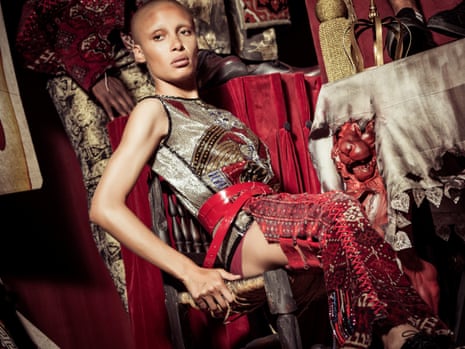
But reflecting, even leading, cultural conversations is what the Pirelli calendar does these days, which may seem bizarre given that it is essentially a promotional exercise for tyres.
This was not always the way. For much of its history the calendar, launched in 1964, was most famous as a place where supermodels took off their kit – sometimes artily – for photographers ranging from Terry Richardson to Herb Ritts.
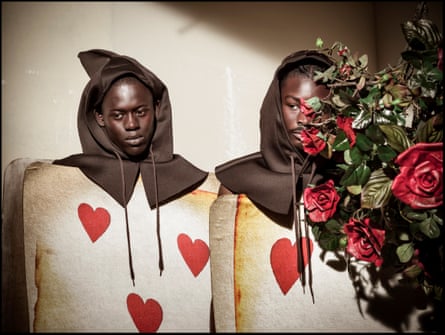
But in 2016 Pirelli commissioned Annie Leibovitz to shoot women known for their “professional, social, cultural, sporting and artistic accomplishment”, including Yoko Ono, Patti Smith, Serena Williams and Amy Schumer, without the male gaze in mind. Earlier this year, Peter Lindbergh’s instalment continued in the same vein, presenting portraits of women with their clothes largely on: Uma Thurman was snapped in a rib-knit roll-neck. Both calendars inspired thinkpieces aplenty.

The cynical might question Pirelli’s motivations for using an all-black cast, and whether its nod to fashion’s vogue for diversity is a little too on the nose. With that box ticked, will Pirelli forget about diversity for its 2019 edition? Will the rest of the fashion industry, for that matter?
None of these concerns are at the fore on set, however, where models wearing vinyl skirts and platform shoes mill around to a soundtrack of Aretha Franklin’s Respect and Otis Redding’s (Your Love Has Lifted Me) Higher & Higher. The dark detritus of fairytale is strewn about – cakes with plastic hands erupting out of them, burnt toast and a looming, giant stuffed hare that refuses to stay upright.
South African Thando Hopa plays the Princess of Hearts. She is a law graduate who worked as a prosecutor specialising in sexual offence cases, and only got into modelling because she “wanted to have a greater level of representation for someone who looks so different” (she has albinism). Invested in the power of images – “you see someone portrayed in a particular way and it gives you inspiration and motivation” –
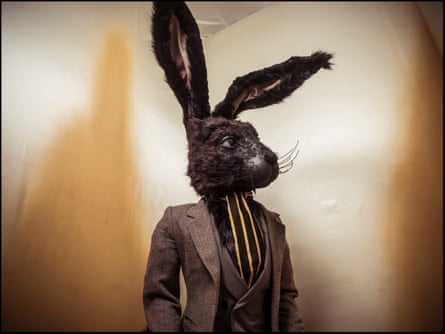
Hopa describes, laughing, her reaction to finding out that Walker planned to make this all-black Pirelli: “I actually phoned him up and I was like: ‘Let’s sit down and talk.’” Walker laid bare his thinking: “He said … any person with a different colour should be able to see themselves in any way. So any girl, whether she is black or Chinese or Indian, they should be able to have their own fairytale.
“This is an important step in culture development – to push images that aren’t generic, that don’t conform to stereotypes,” she says.
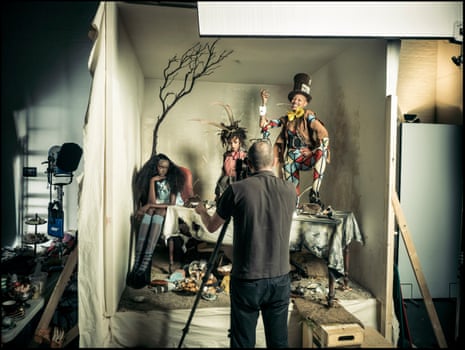
Hopa has considered the response the calendar might get, given that the fashion industry is still far from fully representative. “I hope that people see the intention of this. Personally I don’t find it controversial … I think people really should see the end goal and not obsess in the myopia … this is a unifying effort because now you have Alice looking differently from the way she does. Alice can be anyone.”
Let’s hope that this year’s buzzword – “diversity” – keeps sounding loudly into 2018 and beyond.
